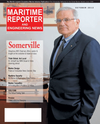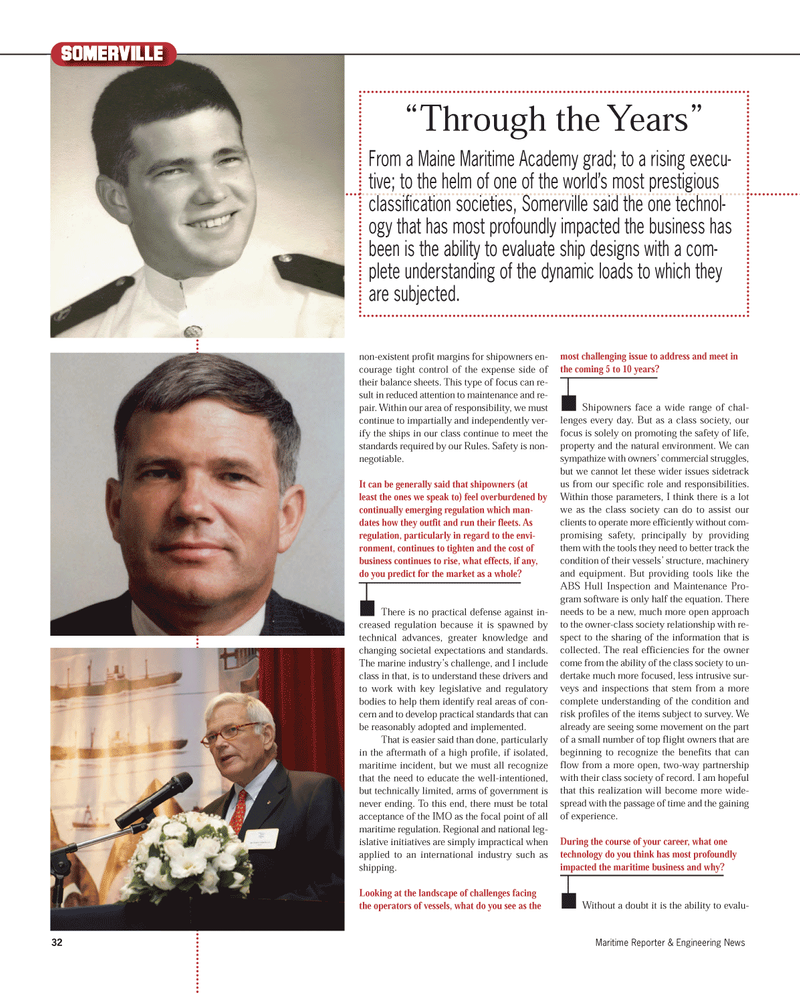
Page 32: of Maritime Reporter Magazine (October 2012)
Marine Design & Construction
Read this page in Pdf, Flash or Html5 edition of October 2012 Maritime Reporter Magazine
32Maritime Reporter & Engineering News somervillenon-existent profit margins for shipowners en- courage tight control of the expense side of their balance sheets. This type of focus can re- sult in reduced attention to maintenance and re-pair. Within our area of responsibility, we must continue to impartially and independently ver- ify the ships in our class continue to meet thestandards required by our Rules. Safety is non-negotiable. It can be generally said that shipowners (at least the ones we speak to) feel overburdened by continually emerging regulation which man- dates how they outfit and run their fleets. As regulation, particularly in regard to the envi- ronment, continues to tighten and the cost of business continues to rise, what effects, if any, do you predict for the market as a whole? There is no practical defense against in- creased regulation because it is spawned by technical advances, greater knowledge and changing societal expectations and standards. The marine industry?s challenge, and I include class in that, is to understand these drivers and to work with key legislative and regulatory bodies to help them identify real areas of con-cern and to develop practical standards that can be reasonably adopted and implemented. That is easier said than done, particularlyin the aftermath of a high profile, if isolated, maritime incident, but we must all recognize that the need to educate the well-intentioned,but technically limited, arms of government is never ending. To this end, there must be total acceptance of the IMO as the focal point of allmaritime regulation. Regional and national leg- islative initiatives are simply impractical when applied to an international industry such asshipping. Looking at the landscape of challenges facingthe operators of vessels, what do you see as the most challenging issue to address and meet in the coming 5 to 10 years? Shipowners face a wide range of chal- lenges every day. But as a class society, our focus is solely on promoting the safety of life,property and the natural environment. We can sympathize with owners? commercial struggles, but we cannot let these wider issues sidetrack us from our specific role and responsibilities. Within those parameters, I think there is a lot we as the class society can do to assist ourclients to operate more efficiently without com- promising safety, principally by providing them with the tools they need to better track the condition of their vessels? structure, machinery and equipment. But providing tools like the ABS Hull Inspection and Maintenance Pro-gram software is only half the equation. There needs to be a new, much more open approach to the owner-class society relationship with re- spect to the sharing of the information that iscollected. The real efficiencies for the owner come from the ability of the class society to un-dertake much more focused, less intrusive sur- veys and inspections that stem from a more complete understanding of the condition andrisk profiles of the items subject to survey. We already are seeing some movement on the part of a small number of top flight owners that are beginning to recognize the benefits that can flow from a more open, two-way partnership with their class society of record. I am hopefulthat this realization will become more wide-spread with the passage of time and the gaining of experience. During the course of your career, what one technology do you think has most profoundly impacted the maritime business and why? Without a doubt it is the ability to evalu- ?Through the Years? From a Maine Maritime Academy grad; to a rising execu- tive; to the helm of one of the world?s most prestigious classification societies, Somerville said the one technol-ogy that has most profoundly impacted the business has been is the ability to evaluate ship designs with a com-plete understanding of the dynamic loads to which theyare subjected. MR#10 (26-33):MR Template 9/28/2012 1:29 PM Page 32

 31
31

 33
33
